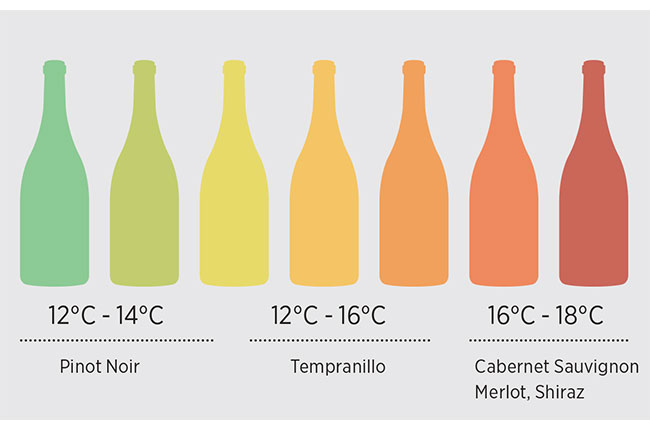A quick guide to the best red wine temperatures
- Light-bodied, or ‘chillable’ reds: Serve these reds slightly chilled. Aim for around 12-13°C (54-56°F), but some can go down to 10°C, too
- Medium-bodied reds: Serve between 14 and 16°C (57-61°F)
- Full-bodied reds: Serve between 16 and 18°C (61-64°F) (cooler is probably better)
What does ‘room temperature’ mean when serving red wine?
The conventional way of thinking about serving red wine has long been the somewhat vague guidance: ‘room temperature’. The problem with this notion is two-fold. One is that it’s awfully subjective. Merriam-Webster dictionary defines room temperature as ‘a comfortable temperature that is not too hot or too cold’.
The thermostat in a given household could differ between one and 10 degrees from its neighbours, so while the definition may have a sort of ‘Goldilocks’ sentiment, ‘just right’ means different things to different people.
Another popular notion that might steer drinkers away from the term ‘room temperature’ is that these guidelines come from a different era. Think of an old country château, its thick stone walls, a fire burning in the hearth. This is a far cry from central heating.
According to Go Compare, the average UK household temperature in 1966 was 12°C (54°F), but these days, it’s 18°C (64°F). In the US, the Department of Energy recommends thermostats be set at 68°F (20°C). In both cases, these current temperatures are in excess or at the upper end of the acceptable serving temperatures for red wine, so using ‘room temperature’ as a guideline will result in a less-than-desirable drinking experience.
Are you serving red wines too warm?
When wines are served too warm, the heat can accentuate some of the wine’s harsher elements. The foremost issue is that the heat accents the wine’s alcohol, giving it a ‘hot’ feeling, which in extreme cases can feel akin to drinking spirits.
In addition, the freshness and acidity that balance the wine’s weightiness and ripe fruit can appear subdued in a warm wine. Wine is a question of personal taste, but these are considered undesirable qualities.
Many of us have probably experienced a ‘soupy’ red wine at one time or another, whether on holiday in a warm climate or in a restaurant without a wine cellar under control. Sticking the wine in the refrigerator or an ice bucket for 10 to 20 minutes can help bring the wine into balance and make for a much more pleasant drinking experience.
Can you serve red wine chilled?
Generally, lighter styles of red wine can be served at lower temperatures. These include red wines that are lighter in style and typically see little to no oak fermentation in the production process. Cool climate varieties like Pinot Noir, Gamay, Schiava and Zweigelt come to mind immediately.
Some light-bodied red wines benefit from chilling, too.
When recommending lighter summer wines for Decanter magazine, Peter Richards MW wrote that ‘good summer reds should be served at 10°C-16°C (50°F-60°F)’.
He added, ‘That’s significantly cooler than many a summer’s day, so don’t be afraid to pop them in the fridge for 30 minutes before serving.’
It can be hard to generalise about particular wines or grape varieties due to variations in winemaking styles. However, Beaujolais (Gamay) and Valpolicella Classico (Corvina) are typically found at the lighter, chilled end of the serving temperature spectrum.
The below graphic from Decanter’s archive shows how Pinot Noir would generally range from light to medium-bodied, with some styles of Rioja (Tempranillo) in the mid-range and then the Cabernet Sauvignon-dominant and Syrah/Shiraz wines of this world in the full-bodied band.

Credit: Annabelle Sing / Decanter
How can you get the serving temperature right?
A wine fridge with pinpoint temperature control is the gold standard for dialling in your serving temperature, but a simple wine thermometer can also help. It might also be helpful to know the room temperature you’re in.
Trust your gut instinct, too. ‘I can’t recall the last time I used a thermometer either at home or in a professional environment,’ sommelier Xavier Rousset told Decanter.
Aside from obvious faults, how balanced does the wine taste?
If a red wine needs warming up slightly, you can always cradle the glass in your hands to improve the experience.
Watch out for temperature changes during drinking, though. ‘The temperature of wine rises dramatically in the glass, so your classic 18ºC Bordeaux becomes (depending where you are) 22ºC or more in the glass very quickly,’ said Rousset.
‘The hardest thing by far is to maintain the correct temperature throughout the time of consumption or over the course of your meal.’







